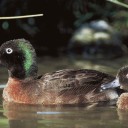
Eradication—The Clearance of Campbell Island
In the largest pest-eradication operation yet undertaken in New Zealand, 11,300 ha Campbell Island was blitzed with rat poison in the winter of 2001. Helicopters, such as this Jet Ranger, buzzing cliffs in the south-west corner of the island, were vital in achieving saturation coverage of the rugged nature reserve. Although the outcome won’t be known until 2003, conservation managers have high hopes New Zealand’s southernmost island is finally rat-free. Project leader Pete McClelland and logistics adviser/photographer Pete Tyree, both of DoC Southland, report on the campaign.
After nearly 200 years of infestation, Campbell Island/Motu Ihupuku may finally be free of rats. A Department of Conservation team spent a month on the island in the winter of 2001 spreading 120 tonnes of poison bait in an attempt to rid the island of the rodents, which have decimated much endemic wildlife.
Almost 700 km south of Bluff, and with an area of 11,300 ha, Campbell Island was the greatest challenge yet for the pest eradication techniques that have been developed, largely in New Zealand, over the past 20 years. Sea cliffs rising to over 300 m—highrise havens for the agile rodents and the island’s consistently adverse weather added to the challenges of size and isolation.
Even 10 years ago, ridding so large an island of rats was an impossible dream. But following a number of successful smaller-scale operations notably on Breaksea Island (26 ha, 1987), Kapiti Island (2200 ha, 1996) and Codfish Island/Whenua Hou (1800 ha, 1998)—and with the help of technological advances such as GPS-equipped helicopters, and growing political support, such dreams are now becoming reality.

Two further island nature reserves due for eradication operations are Raoul Island, in the Kermadecs (3000 ha, to be cleared in July 2002) and Little Barrier/Hauturu Island (1800 ha, scheduled for 2003).
Norway rats arrived on Campbell Island soon after its discovery in 1810 by Captain Hassellburg, of the sealing ship Perseverance. Cats followed, probably introduced by farmers in the early 1900s. Together, these intruders wiped out all the native land birds from the main island, such as the Campbell Island pipit, snipe and teal, along with smaller sea birds, including the storm petrel, diving petrel and various prions. They also reduced the colonies of larger sea birds, such as the grey petrel, white-chinned petrel and sooty shearwater, to a tiny fraction of their former abundance.
Parakeets and rails, too, are thought to have fallen victim to the mammalian onslaught, while a range of invertebrates, including ground weta, giant slugs and several kinds of large weevil, also fared badly. Rats have even been seen diving for mussels.
Cats, never especially numerous, had died out naturally by the 1990s. Derek Brown, a member of the Campbell Island eradication team and a specialist in island management, thinks the cats might have disappeared as a result of the recovery of the island’s vegetation following the removal of sheep.
“A cat can easily run across a grazed paddock. But with no sheep to crop them, the island’s tussock and megaherbs grew taller and thicker. This would have made hunting more difficult, and cats would also have had to push though the vegetation, which, given the island’s climate, gets very wet. So the cats would have been wet and cold, which would certainly have inhibited their breeding, and may thus have led to their demise.”
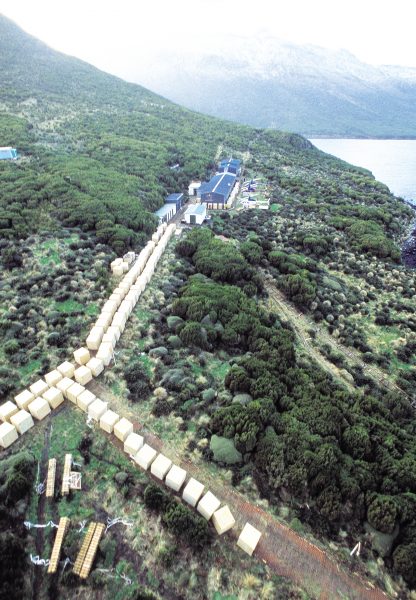
Rats, on the other hand, continued to prosper, and by the time the cats had gone the rodent population was estimated to be fluctuating seasonally between 50,000 and 200,000. The whole island was infested, from the sea-bound cliffs, to the open, swampy ridges, to the shore, where easy foraging along the tide line made for the highest concentrations.
Given the island’s size and remoteness, the usual application of two drops of poison bait totalling 12 kg/ ha was considered neither financially nor logistically feasible. Instead, a single drop of 3 kg/ha was planned, but with adjacent swaths overlapping by 50 per cent to eliminate the risk of gaps in the bait-spread, meaning the whole island would receive a total drop of 6 kg/ha.
To test the effectiveness of this approach, a field trial using bait laced with food dye instead of poison was carried out on the island in 1999. Conducted over an area of 600 ha, the trial indicated all rats would take the bait in the planned operation, every animal trapped in the test area proving, on autopsy, to have dye in its gut.
Two years of intense preparation followed. Resource consent (which DoC, being the regional authority for Campbell Island, could have granted itself) was obtained, for transparency’s sake, from Southland Regional Council. Plans were then drawn up for transporting and storing the enormous quantity of bait required. One hundred and seventy-five collapsible plywood boxes were built, each with a 750 kg capacity, to serve as bait stores and loading platforms.
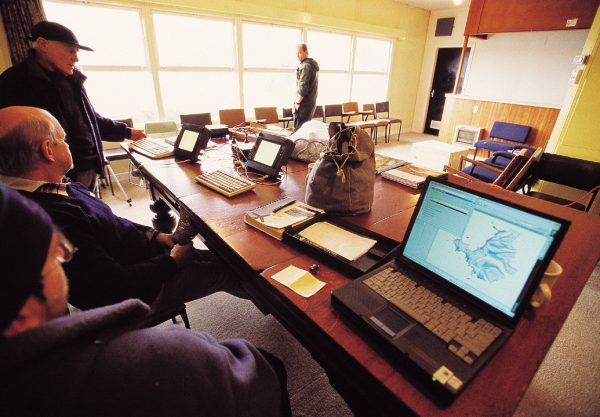
The bait itself came in the form of cereal-based pellets, dyed green to make them less attractive to birds, and spiked with the anticoagulant Brodifacoum. Rats carry the pellets back to their nests and store them in caches, feeding on them whenever they feel hungry. Death follows four to seven days after ingestion.
It was decided the operation had to occur during winter, when penguins, mollymawks and skuas are absent from the island. All three species would have been adversely affected by the presence of helicopters—and skua might also have eaten the poison bait—and the density of birds in the mollymawk colonies would have put the pilots at risk of bird strike.
Weather records indicated that to get the 60 hours of relatively calm, clear weather required for the operation, the team would have to be on the island for three months. As it turned out, unusually good weather meant that the bait drop was completed and the helicopters home in a single month, July 2001.
[Chapter Break]
The 19-member eradication team was based in an old meteorological station, established in the early 1950s and decom missioned in 1995. Although structurally sound, the main building had been stripped of all amenities, apart from bunks and a billiard table, so an advance party was despatched to make it more liveable. A diesel generator provided power for lights, computers, a reliable, pre-electronicera washing machine, and, crucially, a fan for circulating air heated by an ancient coal furnace that was coaxed back into life.
With such a large area to be treated, and bad weather expected to bring frequent delays, the fleet of four helicopters needed to make the most efficient use of its time aloft. To minimise the impact of mechanical failure on the programme, three Jet Rangers—fairly small machines—were chosen to spread the bait, rather than one or two larger craft with greater carrying capacity. A Squirrel helicopter ferried fuel and bait to loading sites near where the Jet Rangers were operating.
Pilots were selected on the basis of experience and their appreciation of the difference between “eradication” and “control.” A seemingly fine point, perhaps, but crucial to the success of the operation. Not even the smallest gap in the bait spread could be countenanced; a few animals missed would spell the failure of the mission.
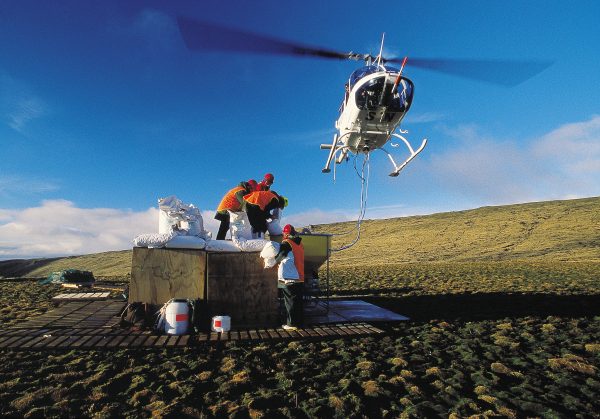
GPS—the satellite-based Global Positioning System—would prove revolutionary in this regard. Over smaller islands, pilots make their bait-spreading runs by sight, using the naked eye to check they cover the entire area. This approach is not precise enough on larger islands, which is where GPS comes into its own. Not only does it allow pilots to see exactly where they are flying, it also records their route on a digital map so they can revisit any areas they may have missed.
Despite the relatively clement conditions the team encountered, kitting up for a working day in the “furious fifties” was always a rigmarole, involving donning under layers, Swanndri, parka and gloves, plus regulation safety gear—helmet, ski goggles, face mask, ear plugs, sealed overalls, fluoro vest and steel-capped gumboots.
Each morning, as soon as it was light (about 8.00 A.M. in the subantarctic winter), chief pilot Peter Garden a veteran of several earlier operations, including the one on Codfish Island—flew off to set up the GPS repeater station on a high point.
At the same time, the loading teams, each five-strong, were flown to their stations, set up on wooden platforms to minimise damage to the island’s peat-soil vegetation. Bags of bait, 30 kg apiece, were opened, ready for loading.
Following instructions from the ground controller, one of the Jet Rangers would approach and set down its spreader bucket on the platform. In a short burst of activity, two people would tip in the bait while two more grabbed the empty bags to ensure they didn’t swirl up into the rotor blades. Then, as the helicopter lifted off to deliver its payload, more bags would be hauled out and opened, the empties stowed and any empty boxes dismantled.
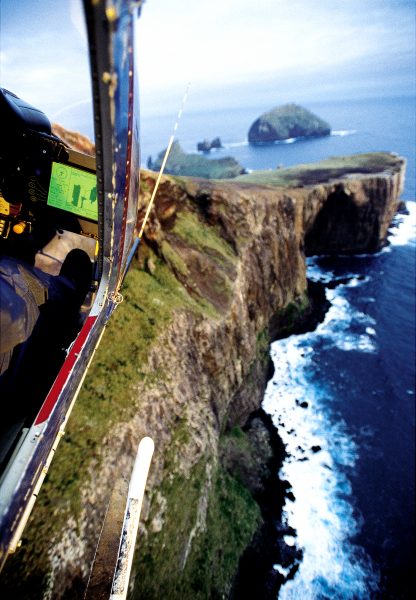
A spell of quiet would follow, only to be interrupted by the Squirrel bringing up more bait. This would have to be unloaded and stacked, and used boxes and bags stowed in the cargo net in its place. Another quiet spell, then the next incoming Jet Ranger would be heard—sometimes two at the same time, resulting in a frenzy of activity. If cloud rolled in a frequent occurrence—the team could only sit and wait until it cleared or the day’s work was called off.
The stop–start routine played havoc with body temperatures, Pete Tyree recalls: “The work was hot and fast, but then you’d stop and freeze.
Management of sweat was critical.”
Not so for the pilots, hunched behind their controls. With doors removed to give an unimpeded view of the bait bucket dangling beneath, cockpits were constantly cold. Nevertheless, as he swept to and fro across the island, Garden couldn’t help but be impressed by the wizardry of GPS. A light bar guided his steering, showing green when he was on course and red whenever he deviated to either side, while his position, flight line and swath were plotted on a map marked with parallel lines.
“All you had to do was fly along the lines, filling in the gaps. It was like painting by numbers.”

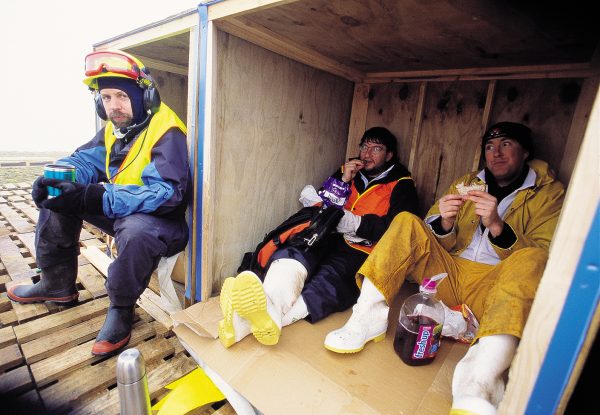
Nevertheless, the pilots had to exercise great care in following their flight paths. Turbulence could knock them off course, meaning they’d miss a small area. Back at base, computer operator Glen Tomlinson would download each day’s flying, so it could be checked for gaps and return trips planned as required.
Particular care was necessary along the island’s sea cliffs, pilot Bryan Beck’s preserve. Not only was there the danger of vicious updrafts, but especial thoroughness was required to land sufficient bait on ledges and in clefts likely to be frequented by rats. Flying as close as 15–20 m from the cliff face, Beck would make as many as three or more passes along the same stretch, pellets spraying from the bucket and tumbling down the precipice until finding places to lodge.
Another hazard for the pilots was the island’s resident southern royal albatrosses. Although the giant birds (the world’s largest seabird) could easily avoid the helicopters when these were flying at normal operational speeds of around 50 knots, they appeared to have a problem with higher speeds.
“They are considerably better fliers than helicopters can ever be,” says Garden, “but if we were doing 60 or 70 knots they seemed to have difficulty anticipating closing speeds and angles.” Which meant a collision was always a possibility, with potentially serious consequences for bird, man and machine.
Fortunately there were no accidents, and the albatrosses, along with the rest of the island’s wildlife, were nothing but a source of wonder for all present.

Sea lions by the wharf at Perseverance Harbour seemed to be attracted by the pulsing of rotor blades above the water. “They’d come from all over the harbour, ducking and diving and performing somersaults,” recalls Garden.
The southern right whales in Northwest Bay, meanwhile, had other things on their minds, having gathered to breed. Their eerie moans, the puffs of spray from their blowholes and their amorous courtship behaviour were a stirring sight.
Any concern that the presence of humans and their raucous machines might disturb the island’s wildlife was soon dispelled. In fact, besides the rats, those most in danger from human activity were probably the team members themselves, working as they were in difficult terrain, often at breakneck speed. Nevertheless, in a remarkably trouble-free operation, injuries were few and minor. Medical officer Sally Lanauze was required to treat nothing worse than a cut finger, sustained in the kitchen. As one of the pilots was quick to point out, this meant the kitchen was the most dangerous place on the island, and therefore he should avoid it and its attendant chores as much as possible!
More severe injury might have resulted when one of the motorised spreaders didn’t shut off during loading. The ground crew dived for cover as the spreader, which fires pellets fast enough to carry them 30–40 m either side of the bucket, pelted the area with bait.
A few cuts and bruises aside, the entire bait-spreading operation went without a hitch. When it was finished in a single month, instead of the three that had been budgeted on, some of the team couldn’t help wondering, “What have we done wrong? That was too easy.”
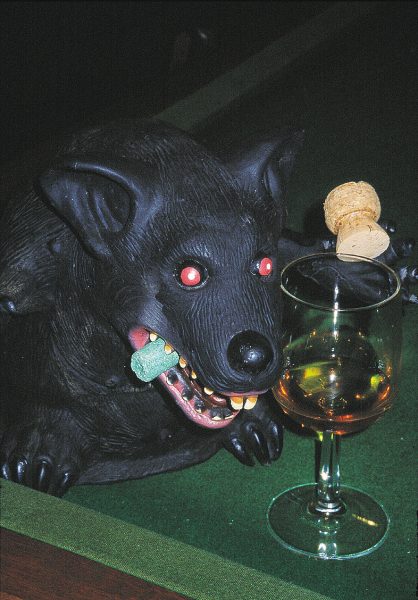
The department won’t know until 2003 whether the operation has been successful. There is no point checking before then because any survivors—and, of course, everyone hopes there aren’t any—won’t have reached detectable numbers. On the face of it, though, the Campbell Island operation has set a new standard for rodent eradication campaigns.
Success on Campbell will open up a range of possibilities. Beyond the remaining islands in the current programme Raoul and Little Barrier—some people are starting to contemplate the likes of Great Barrier and even Stewart Island, places with both multiple pest species and permanent human populations.
Plans to clear the vast 51,000 ha Auckland Island of pigs and cats are already in hand. And, as island successes accumulate and ever-more sophisticated techniques are perfected, the widespread control of pests on the mainland also looks increasingly feasible.
International opportunities beckon, too. Kiwi expertise in ridding islands of rodent pests is proving a commodity with considerable export potential. New Zealanders have advised and assisted in eradication operations in the Seychelles, the Falkland Islands and Western Australia’s Monte Bello archipelago, and helped with feasibility studies in Tonga and on South Georgia and Lord Howe Island. Plans for Cocos Island, a Costa Rican outpost in the Pacific, are also benefiting from New Zealand input. Other projects are in the offing as feelers come in from around the world.
Campbell Island may not be the last word in pest eradication, but it represents a huge step forward. Among DoC managers the feeling is: If we can do Campbell, we can do almost anywhere in the world.

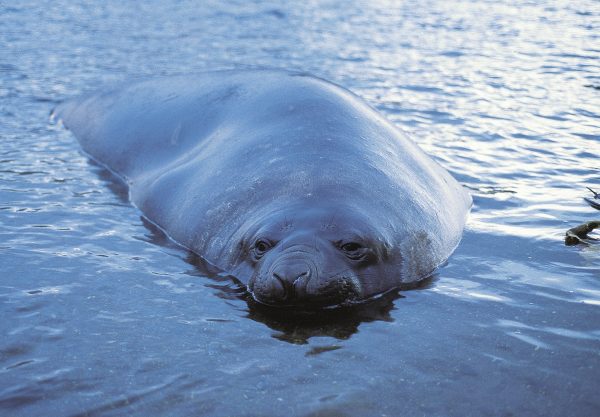
With the rats gone, Campbell Island will become the domain once more of those species they took to the very brink of extinction. The reintroduction of captive-bred teal, a tiny population of which survives on offshore Dent Island, is planned for 2004, while snipe, now found only on outlying Jacquemart Island, will either be left to re-colonise in their own time or given a helping hand via translocation or captive breeding.
Smaller seabirds, also exiled to outlying islands, should return under their own steam, while larger species, clinging on in straitened circumstances on the main island, will flourish once again.
The tale of chilly Campbell Island is one to warm the hearts of conservationists and wildlife lovers everywhere.









